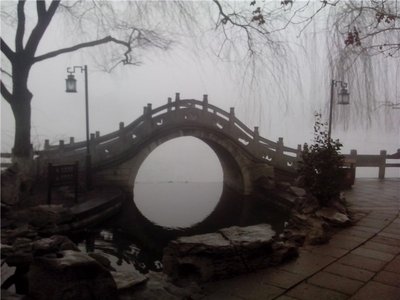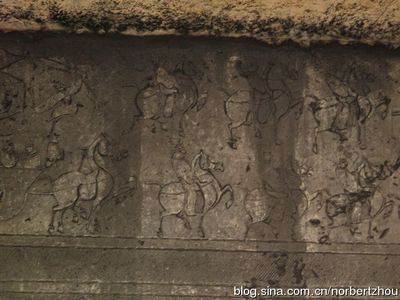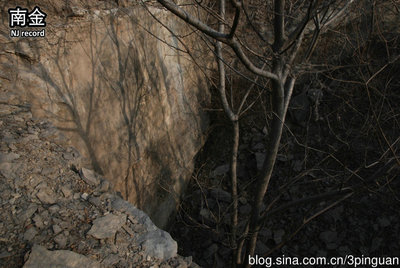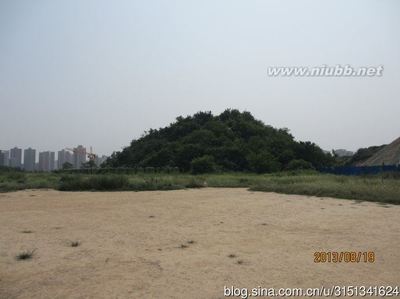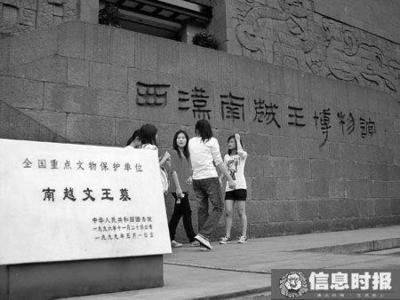岭南名胜中英文导游(16)
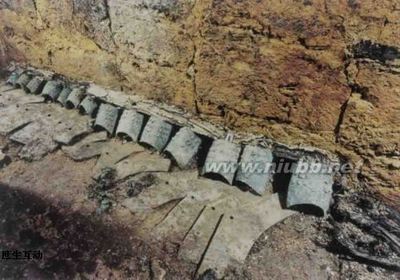
西汉南越王墓博物馆
Nanyue King Museum
[简介]
“西汉南越王博物馆”位于广州解放北路的象岗山上,是中国西汉时期南方的地方政权南越国国王赵昧的陵墓。南越国传五代历93年,汉武帝元鼎六年(公元前111年)归属西汉。赵昧是南越国第二代王,汉武帝建元四年继位,称文帝,在位16年(公元137—122年)。
南越王墓于1983年发现。陵墓深入地下20米,用750多块红色砂岩石筑成;面积约100平方米,分前后两部分,共七个室。此墓是岭南地区发现的规模最大,出土文物最丰富、墓主人身份最高的一座汉墓;共出土文物1000多件(套),以铜、铁、陶、玉四类物品为主,其中“文帝行玺”金印是中国考古发掘出的首枚“皇帝”印玺,最为珍贵。南越文王墓的出土,被誉为近代中国考古的五大新发现之一;陵墓现已辟为博物馆。
[Introduction]
TheNanyue King Museum, formerly named Nanyue Tomb Museum, was set upat the site of the tomb of a Nanyue King, Zhao Mo by name, whostyled himself “Emperor Wen ” and was the second king of the NanyueKingdom , being on the throne for 16 years in 137 – 122BC . TheNanyue Kingdom was a local state in South China in the period ofChina’s Western Han Dynasty . It lasted 93 years with 5 kings insuccession and submitted to the Western Han in 111 BC .
The tombof Zhao Mo was discovered in 1983 ,20 meters under the ElephantHill at Jiefangbei Road in Guangzhou . With an area of about 100square meters. It is constructed with 750 blocks of red sandstones,with 7 chambers in all. This tomb is the most important Han Tomb sofar discovered in South China – its size is the largest, thepolitical and social status of its occupant is the highest and thenumber of historical relics unearthed is the greatest – and so isconsidered as one of the 5 major archaeological finds in modernChina. Articles unearthed from the tomb, totaled over 1000 piecesor sets, fall mainly into 4categories: copperware, ironware,earthenware and jade ware. Among all the articles unearthed, thegold seal inscribed with the words “The Seal of Emperor Wen” is themost precious because it’s the first emperor’s seal so fardiscovered in China’s archaeological excavations. Now the tomb andthe unearthed artifacts are all on display in the Nanyue KingMuseum.
[金印]
南越王墓出土的“文帝行玺”金印是我国考古发掘出土的第一枚帝印。在传世或发掘出土的秦汉印章中,未见其他皇帝印玺,只有文献记载;而且文献记载的帝印都是白玉质螭虎钮印,而南越国赵眛这枚帝印却是金质印、螭虎钮印,是南越国自铸、赵眛生前实用之印。除“文帝行玺”金印外,墓中还出土了“泰子”金印和“右夫人玺”金印,但不是龙钮,而是龟钮。另外,还有一些金质饰品,如,金带钩、金花泡、杏型金叶等。
[Gold Seals]
The goldseal of Emperor Wen unearthed from the Nanyue King’s tomb is theonly extant emperor’s seal left over from the Qin and HanDynasties. Until it was excavated, emperor’s seals of the Qin andHan Dynasties were known only in historical documents. Moreover ,the emperor’s seals record in historical documents are said to bemade of white jade with a handle of a tiger , but this seal of ZhaoMo’s is made of gold with a handle of a dragon . It was made in theNanyue Kingdom and was the real that Zhao Mo actually used duringhis lifetime.
Besides the gold seal of Emperor Wen , a gold seal of “Taizi”(meaning “the prince ”) and z gold seal of “You Furen ”(meaning of the “ wife of the king” ) were also unearthed from thetomb , but they are knobbed with a turtle instead of a dragon .Other gold articles unearthed include gold belt hooks, bubble-likegold flowers and among -shaped leaves and so on.
[银器]
墓中出土的一件白色的银盒特别引人注目。此盒出土时在墓主棺室,内盛半盒药丸。该盒从造型及纹饰工艺特点来看与中国传统银器的风格迥异;经化学分析和专家研究,认为是波斯产品,里面的药丸很可能是阿拉伯药,因此该银盒为海外舶来品。墓中出土的银器还有银洗、银卮和银带钩等,都是南越王室的专用器具。
[Silverware]
A whitesilver box unearthed from the tomb is quiteunusual. It was found in the main coffin chamber,with half of it containing a kind of substance that looked likemedicinal pills. Judging from its shape and ornamental design ,which are greatly different from those of the traditional Chinesesilverware , and by chemical analysis of the pills , archaeologistsbelieve that it is a product of Persia and its contents are a kindof Arabian medicine . Other silver articles unearthed from the tombare washbasins, wine-vessels,belt hooks and so on. They were all utensils for the royalfamily.
[铜器]
墓中出土的铜器多达500件;有厨具、饮食用具、乐器、车马器、生产工具及各种日月器具如铜鼎、铜镜、铜鉴、铜熏炉等,不但品种数量多,而且制作工艺精湛,极具地方特色;它们不仅反映出南越国当时的铸造技术水平,而且是广州建城历史的重要物证。其中一铜鉴(深鼓腹大盆,可用来盛水或食物)出土时盛有猪、牛、羊、鸡骨和鱼、龟等水产,说明这些东西是当时的主要食物。
[Copperware]
Bronzearticles excavated from the tomb amount to 500 pieces and more.They are kitchen utensil , tableware , musical instruments , horsecart harness , implements for production and other daily utensilssuch as tripods , mirrors , basins and candlewood-burners .They areall articles of excellent workmanship distinctive local feature ,witch not only represent the technological level of metal-castingof the Nanyue Kingdom but also sere as an evidence for the historyof the founding of the city of Guangzhou .One big bronze-basin whenunearthed , was found containing bones of pig cow , goat , chicken, fish and turtle , witch is an evidence to prove that theseanimals were some of the staples of people’s diet .
[乐器]
南越王墓东耳室出土了一批各式各样的乐器,如钮钟、角钟、铜句耀等;出土时旁边还有一名殉葬的乐师。其中一句耀上刻有“文帝九年乐府工造”的字样,说明此乐器是公元前129年制造;经测定,此句耀音质尚好,仍可演奏,弥足珍贵。
[Musical Instrument]
A lot ofmusical instruments were discovered in the east side-chamber of thetomb Among them the one called “Gou Diao” is especially worthmentioning .It is a chime of bronzes , 8 pieces in all , totaling191 kilos in weight ,with one bigger than other and the biggest oneis 64 centimeters high and 40 kilos in weight .On the surfaces ofthe 8 bronzes are cast with an epigraph “Made in the OfficialConservatory in the Ninth Year of Emperor Wen ” , which shows thatthe instrument was made in Nanyue Kingdom in the year 129 BC .And ,although over 2100 years old , the still produce clear and accuratenotes !
[兵器]
墓中出土了一大批各式各样的兵器,如戈、铜剑、铜虎节、铁剑、铠甲和铁矛等。其中一把铜戈上刻有“王四年相邦张义”的字样,说明此戈是秦惠王时由张仪监造、由秦带入南越的。出土的铜虎节是一件国内仅存的错金虎节。节是外交和军事上的信符,可以用来征调战车和士兵。兵器中有洗错金银图纹的铁矛;从其华丽的装饰上看,此铁矛应为南越王自用的兵器或用于仪仗。
[Weapons]
Weaponsunearthed from the tomb are many and varied :dagger-axes , coppersword , iron swords armors and iron spears , to mention just a few.One copper dagger-axes is engraved with an inscription from whichwe can know that dagger-axes was made in the Qin and brought to theSouth .One spear is believed to be a weapon actually used by theking himself or for use as an article to be carried by a guard ofhonor , because it is gorgeously decorated with inlaying gold andsilver designs .Besides weapons for combat , a bronze tally in theshape of a tiger was also discovered .The tiger tally was a objectof credential issued to officials as imperial authorization fortroop movement or for use on diplomatic occasions .It is the onlygold-inlaying tiger tally still in existence in China .
[玉器]
南越王墓出土的玉器有一件丝缕玉衣、56件玉璧、9枚玉印章、130多件玉配以及玉盒、玉角杯等。玉衣是汉代特有的丧葬殓服,通常为金缕、银缕或铜缕,而南越王墓出土地玉衣却是丝缕,为首次发现,也是至今发现的唯一的一件丝缕玉衣。整件玉衣全长1.73米,共用玉片2291块,用朱红丝带粘贴,构成多重图案,色彩鲜艳夺目。出土的56块玉璧中有47块在主棺室;其中一块直径达33.4厘米,是我国考古出土玉璧中形体最大的一块玉璧。9枚玉印中有枚分别刻有赵昧、泰子、帝印字样,均出自主棺室墓主的身上,是赵越称帝物证。
[Jade ware]
Jadearticles unearthed from the tomb include a jade garment sewn withsilk threads , 56 pieces of jade discs (called “bi” in Chinese ) ,9 jade seals , 130 pieces of jade pendant , jade boxes , jade cups, etc .Using jade garments as cerements for clothing the dead was apractice peculiar to the Han Dynasty .Such jade garments discoveredbefore were sewn with gold , silver or bronze stands .But the jadegarment for Zhao Mo was sewn with silk strands – the first and theonly one so far discovered in China .This jade garment , 1.73meters long , is made of 2291 pieces of jade that are strungtogether with red silk strands , forming different beautifulpatterns .Of the 56 pieces of jade discs , 47 were discovered inthe main coffin chamber , of witch one is 33.4 centimeter and isthe biggest of its kind so far unearthed in archaeologicalexcavations in China .Of the 9 seals unearthed , 3 were found onZhao Mo’s body and are inscribed respectively with the words “ZhaoMo” , “Tai Zi ” (the prince) and “seal of emperor” , which is anevidence for the fact that Zhao Mo overstepped his authority tostyle himself “emperor” to break away from the Han exercise localpower .
[陶器]
南越王墓出土陶器共371件,特别值得一提的是打上“长乐宫器”戳印的四件陶鼎和陶瓮。长乐宫本是汉代首都长安的皇宫里最重要的宫殿,是汉皇帝和太后居住的地方。这四件有“长乐宫器”戳印的陶器是否说明南越国宫殿里也有“长乐宫”?最近,考古工作者在广州原儿童公园东边试掘出约500平方米的南越国宫殿遗址;此处在南越国宫殿中的位置正好与长安汉皇宫宫中的长乐宫所处的位置相符,它是否就是南越国宫殿中的“长乐宫”?此推断还有待证实。
[Earthenware]
Altogether 371 pieces of earthenware were discovered in the NanyueKing’s tomb .Among them are 4 pieces of earthen jars and tripodsthat are stamped with the words “Article of Chang Le Gong” . “ChangLe Gong” (meaning Palace of Everlasting Joy ) was the name of theresidential quarter for the mother and queen of the Han Dynastyemperor in the imperial palace in Chang’an (the present-day Xi’an ).Do these 4 earthenware articles suggest that there was also a“Chang Le Gong” in the Nanyue king palace ? In recent years ,archaeologists have excavated on trial 500 square meters of theruins of the Nanyue king palace in the original site of Guangzhou’sChildren’s park .They discovered that the place under excavationoccupied just the same position in the Nanyue king palace as theChang Le Gong was located in the Han imperial palace was located ?These questions remain yet to be decided by further studies andresearch work.
[殉人]
南越王墓中共发现15具殉人。前室一具,身份是“景巷令”;东耳室一具与乐器同出,可能是乐伎;东侧室有四具,为南越王的夫人;西侧室有七具与厨具同出,可能是厨师或杂役;墓道中有两具,可能是卫兵;另一具在外藏室中,可能是车夫。活人殉葬现象商、周时期曾在中原地区盛行,但至汉朝时已基本不存在。南越王墓中发现众多殉人,说明这种残酷的殉葬制度当时仍被南越国统治阶级所沿用。
[Sacrificial Persons]
In thetomb , fifteen persons were found buried alive with the dead : onein the front chamber , who was perhaps a eunuch ; one in the eastside-chamber , who was buried together with musical instruments andwas probably a musician ; four women in the east side-chamber , whowere concubines of the king ; seven in the west side-chamber , whowere found staying together with kitchen utensils and would becooks or kitchen helpers ; two in the passageway , possibly guardsof the tomb ; and one in the outer coffin , probably a cart-driver.
Theinstitution of burying the living with the dead sovereigns hadprevailed in Center China during the Shang and Zhou dynasties(1766-770BC.), but was on the whole abolished in the Han Dynasty(206BC – AD220) .The discovery of the sacrificial persons in thetomb of the Nanyue king shows that this cruel and savageinstitution was still practiced by the ruling class of the class ofthe Nanyue Kingdom.
(《导游实训教材》Timw等 编)
 爱华网
爱华网